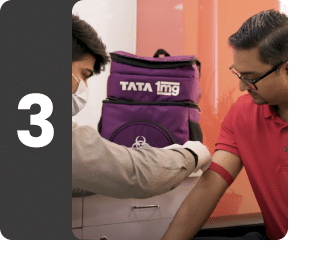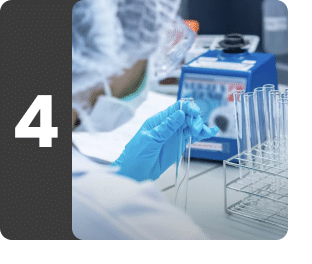Differential leucocyte Count
Understanding Differential leucocyte Count
What is Differential leucocyte Count?
Leukocytes or white blood cells (WBCs) are blood cells which form an integral part of the immune system of the body. There are five types of WBCs with each of them having different functions. Differential Leukocyte Count Test measures the total number of all the WBCs in blood.
What is Differential leucocyte Count used for?
The Differential Leukocyte Count Test is performed:
· As a part of Complete Blood Count (CBC) Test in regular health checkups
· As follow up test in case of abnormal CBC results
· To help diagnose infections and inflammation
· To help diagnose conditions that decrease WBC count like bone marrow disorders
· To monitor bone marrow function
· To monitor chemotherapy treatment
What does Differential leucocyte Count measure?
Contains 5 testsBlood is made up of different types of cells which are suspended in a fluid called plasma. These include erythrocytes or red blood cells, leukocytes or white blood cells, and platelets. Blood cells are produced by the hematopoietic cells in bone marrow and are then released into circulation. RBCs carry oxygen to the tissues, platelets help in blood clotting at a site of injury, and leukocytes form an integral part of the immune system of the body.
WBCs are of five types, each having a different function and present in different numbers:
1. Neutrophils: Under normal conditions, the number of neutrophils present is higher than any other type of WBCs.. They provide protection against pathogens, mostly bacteria and sometimes fungi. Neutrophils engulf the pathogens completely and digest them (the process is called phagocytosis). They are usually associated with acute or short-term infections.
2. Eosinophils: Eosinophils are WBCs that are primarily responsible to fight parasitic infections. They are also involved in allergic reactions and regulation of the extent of immune response.
3. Basophils: Basophils are WBCs which are present in the lowest numbers in circulation. They are considered to play an important role in allergic response.
[Neutrophils, eosinophils, and basophils are together classified as granulocytes. Granulocytes are the WBCs which contain granules present in their cytoplasm. These granules secrete chemicals during immune response.]
4. Monocytes: Monocytes are WBCs which are also involved in protection against infectious pathogens by phagocytosis like neutrophils. However, monocytes are more commonly associated with chronic or long-term infections.
5. Lymphocytes: These are specialized WBCs which are responsible for recognizing and neutralizing foreign (non-self) cells and cancer cells in the body. Lymphocytes are of three types, all of which are differentiated from a common type of lymphocyte progenitor cell:
· T cells or T lymphocytes are produced in the bone marrow and mature in the thymus gland. They are responsible for differentiating between self and non-self cells of the body. T cells are also responsible for the initiation and extent of immune response, and targeted destruction of cancer cells and virus.
· B cells or B lymphocytes are control acquired immunity by producing antibodies against antigens found on foreign cells and pathogens like bacteria and viruses.
· Natural killer cells or NK cells destroy all foreign cells tagged by antibodies, cancer cells and virus-infected cells by phagocytosis.
Depending on various factors like age, gender, health condition, environmental factors, etc., varying amounts of different types of WBCs circulate in the blood. The bone marrow increases production of WBCs in response to an infection or inflammation anywhere in the body, which are then called to the site by a series of chemical signals, where they work to treat the condition. Depending on the condition, the count of one or more types of WBCs remains high in the blood. Once the condition subsides, WBC production by the bone marrow decreases and their count in circulation falls back to normal levels. Elevated amount of one or more types of leukocytes for a long time may be an indication of a chronic condition that is not resolving naturally and might need urgent attention.
Apart from an infection or inflammation, WBC count in blood can also be affected by other conditions like disorders of the immune system, autoimmune conditions, cancer, etc. One or more types of WBC count may be higher or lower than normal in these cases.
Differential Leukocyte Count Test serves as an indication of a condition affecting the body. Further tests are performed to confirm a particular condition and direct treatment.
Differential Basophil Count
Differential Neutrophil Count
Differential Lymphocyte Count
Differential Monocyte Count
Differential Eosinophil Count
Interpreting Differential leucocyte Count results
Interpretations
Normal range (Approx.):
Component | Mean number fraction | Absolute counts X 109 per liter |
Segmented Neutrophils | 0.56 | 1.8-7.8 |
Eosinophils | 0.027 | 0-0.45 |
Basophils | 0.003 | 0-0.20 |
Lymphocytes | 0.34 | 1.0-4.8 |
Monocytes | 0.04 | 0-0.80 |
Note: Normal range of leukocyte count depends on a number of factors apart from age, including gender, health condition, previous instance of diseases, vaccinations, etc. The range also varies slightly between different laboratories performing the test.
The results of the differential leukocyte count may be interpreted in combination with other tests as follows:
Type of WBC | Conditions causing higher than normal count | Conditions causing lower than normal count |
Neutrophils | Known as neutrophilia · Acute infections, mostly bacterial, and in some cases viral or fungal · Inflammatory conditions like rheumatoid arthritis · Necrosis (tissue death) caused by burns, trauma, surgery, heart attack, etc. · Heavy physical exercise and stress · Smoking cigarettes · Third trimester pregnancy and labor · Chronic leukemia | Known as neutropenia · Myelodysplastic syndrome · Severe infections like sepsis · Certain drugs like penicillin, ibuprofen, etc. · Autoimmune disorders · Chemotherapy · Cancer that spreads to bone marrow · Aplastic anemia |
Lymphocytes | Known as lymphocytosis · Acute viral infections like hepatitis, chicken pox, herpes, etc. · Certain bacterial infections like whooping cough, tuberculosis, etc. · Lymphoma · Lymphocytic leukemia | Known as lymphopenia or lymphocytopenia · Autoimmune disorders like systemic lupus erythematosus, rheumatoid arthritis, etc. · Infections like AIDS, tuberculosis, hepatitis, influenza, etc. · Bone marrow damage due to chemotherapy · Immune deficiency |
Monocytes | Known as monocytosis · Chronic infections · Heart infections like bacterial endocarditis · Collagen vascular diseases like systemic lupus erythematosus, scleroderma, rheumatoid arthritis, vasculitis, etc. · Inflammatory bowel disease · Monocytic leukemia · Chronic and juvenile myelomonocytic leukemia | Known as monocytopenia A single low count is medically insignificant. Low counts in subsequent tests may be indications of health conditions. Repeated low counts can indicate: · Hairy-cell leukemia · Bone marrow damage or failure |
Eosinophils | Known as eosinophilia · Asthma · Allergies such as hay fever · Drug reactions · Inflammation of skin like eczema, dermatitis, etc. · Parasitic infections · Inflammatory diseases like celiac disease, inflammatory bowel disease, etc. · Certain cancers · Hypereosinophilic myeloid neoplasms | Known as eosinopenia Eosinophil count is normally low and lower than normal counts may be difficult to determine. One or an occasional low number is usually not medically significant. |
Basophils | Known as basophilia · Rare and severe allergic reactions like hives, food allergy · Inflammation due to rheumatoid arthritis, ulcerative colitis, etc. · Some leukemias like chronic myeloid leukemia | Known as basopenia Basophil count is normally low and lower than normal counts may be difficult to determine. One or an occasional low number is usually not medically significant. |
Book a Differential leucocyte Count test at home near me





Other tests








